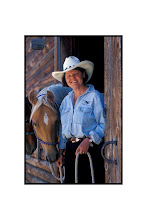Ranch Report for the Students
Hello to the students at the Col. Johnston Elementary School on Ft. Huachuca Army Base in Arizona. As you may know, your teacher is planning a visit to our ranch during spring break. I thought you might enjoy getting acquainted with our outfit and learning a little about ranching in the Rocky Mountains.
Much of what ranchers do in the summer is get ready for Montana winters--we grow the feed and bale the hay that it takes to feed our animals in the cold weather months of winter and spring.
In many ways the ranch seasons are the same as your school seasons as we begin a new year each fall. Lambs and calves are weaned and sent to market or put on special feed where they will grow to adults and find their way to back to the herd as a mother. A veterinarian helps us to screen our cows in the fall and we keep the pregnant cows and sell the older cows that can no longer have babies. We say they go “to the Golden Arches” because it is likely that they will be ground into hamburger and served on a bun at McDonalds! A cow will be pregnant for nine months, just like a human. This is the gestation period or the time it takes for a baby to be born. That period is only 145 days (5 months) for sheep. Our cows will begin calving right around Valentines Day in February and our sheep will begin lambing toward the end of March, just about the time your teacher comes for a visit.
In addition to the 260 cows and 200 sheep and dozen horses which live at our ranch, we have as many as 200 resident deer grazing in our hay fields. It is not uncommon to spot deer, antelope, jack rabbits or raccoons in our pastures. We watch for bald eagles and the various hawks and mountain birds that greet us each day. In the evenings we can hear the coyotes yipping and the great White Pyrenees dogs barking their reply. We have two older dogs named Zsa Zsa and Yukon and they have been guarding the sheep for 10 years now. Before that time as many as one-fourth of the lambs would be killed by coyotes. The dogs live with the sheep and protect them from the coyotes. Because the guard dogs are getting older, we purchased two Pyrenees puppies this summer named Eva and Elvis. They are bonded to the sheep and the older dogs are teaching them the routine. They would give their life to protect the sheep. These dogs are much respected and loved for their faithfulness to the sheep.
We also have cow dogs at the ranch. Our old timer “top dawg” is named Bernie and he spends more and more time on the porch while our young Border Collie named Rascal likes to work. Some times he likes to work too much and we have to make him stay behind. We joke that some people are like the horse whisperer but Grandpa is the “dog bellower” because he has to holler at Rascal to make him mind. Rascal makes us laugh because he is always playful and he gets into mischief. Only on days when he has gotten too close to a skunk do we avoid him until he smells better. Life is never boring when Rascal is around.
We feel very fortunate to live on a ranch and we enjoy sharing our way of life with others. I would encourage you to ask any questions you may have about ranching. If you let me know what you are particularly interested in, I’ll email back and tell you more about life on a Montana family-owned ranch.
As Grandpa says, we do not inherit the land from our parents; we borrow it from our children. And with that comes a responsibility to be good stewards of the land so that people of your generation have a chance to explore wide open spaces and learn about ranching traditions.
Happy Trails,
Karen
